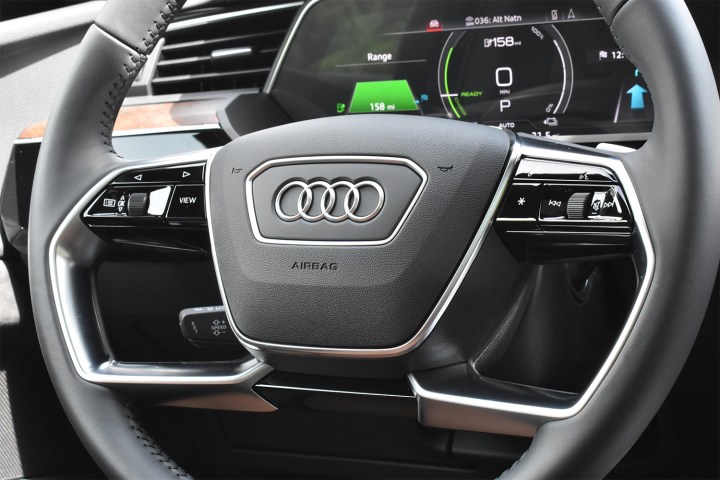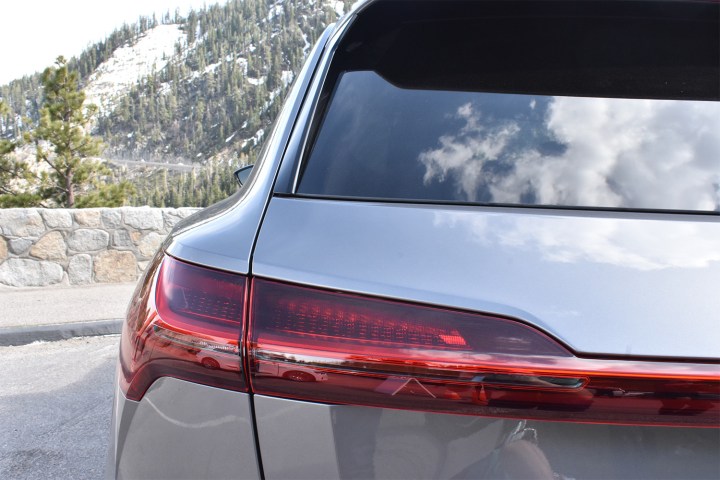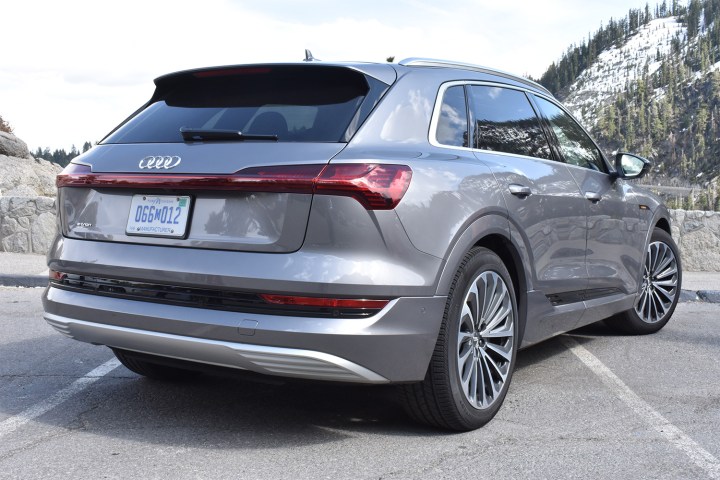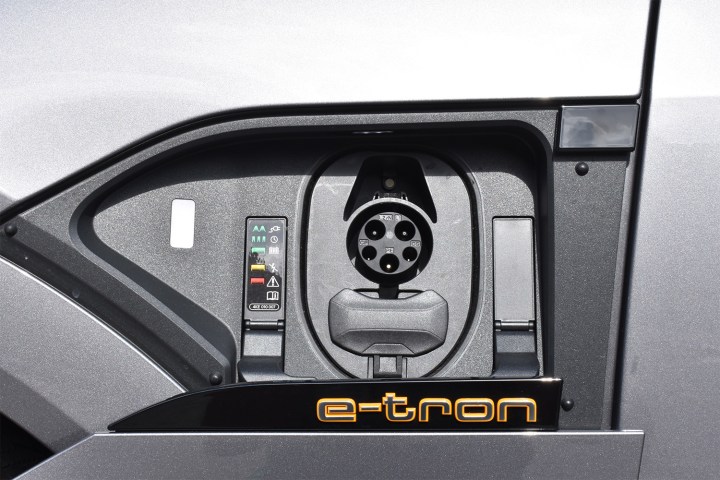“The most appealing thing about the 2019 Audi E-Tron is how normal it feels.”
- Comfortable and quiet cabin
- Interior space
- Poised handling
- Lifeless steering
- Poorly-executed “frunk”
Audi has been very eager to show off its first series-produced electric car, the 2019 E-Tron. We’ve already thrashed a prototype across Namibia, and driven an international-spec version in Dubai. But those weren’t exactly everyday conditions, and the vehicles differed in key ways from what U.S. customers get.
To get a better idea of how the E-Tron works in the real world, Audi invited us to drive it from California’s Napa Valley to Lake Tahoe, with a stop along the way in Sacramento to recharge. The car we drove was identical the ones U.S. customers can buy. Pricing starts at $75,795 for the base Premium Plus trim level, rising to $82,795 for the Prestige trim level (both prices include a mandatory $995 destination charge).
The E-Tron qualifies for the $7,500 federal electric-car tax credit, and likely will for some time. Since Audi is just starting to sell electric cars, it’s nowhere near the 200,000-unit mark that triggers a phase out of the credit. The E-Tron may also qualify for state and local incentives, depending on where you live.
Flying Under The Radar
Audi took a very different approach to design compared to its rivals. You won’t find anything to match the . Instead of going for a futuristic design like others, Audi made the E-Tron look like all of its other SUVs. This is not a bad thing. A silver grille and charge ports are the only real hints that the E-Tron is electric.
As the first of many Audi electric cars, the E-Tron needs to make a strong first impression. That’s hard to do when the finished product looks like just another SUV, but Audi won’t have to worry about driving customers away with polarizing styling. Audi is going for mass appeal here, which is why it made the E-Tron an SUV in the first place.
From an EV engineering perspective, it really doesn’t make much sense for the E-Tron to be an SUV. It’s bigger and heavier than a comparable sedan, and less aerodynamic. Audi tried some tricks, such as inlets in the front bumper to direct air around the wheels, and an air-suspension system that automatically hunkers the car down at speed, but that can only do so much to overcome the extra width and height of an SUV body compared to a sedan. At 0.30, the E-Tron’s drag coefficient can’t match the 0.25 of the Tesla Model X or 0.29 of the Jaguar I-Pace.
But an SUV of this size (the E-Tron is between the current Audi Q8 and Q5 in size) will draw in the most sales, according to Audi, particularly in the U.S. Given the current buyer obsession with SUVs, it’s hard to argue with that logic.
Audi is going for mass appeal here, which is why it made the E-Tron an SUV.
The E-Tron’s more conventional SUV styling also pays dividends in passenger and cargo space. The Audi has slightly less front headroom than the Jaguar I-Pace, but because it doesn’t have the Jaguar’s sloping roof, rear-seat passengers get more headroom. The E-Tron also offers substantially more rear legroom and rear cargo space than the Jag. Mercedes-Benz hasn’t published full interior specs for its upcoming EQC, but since it’s smaller overall than the E-Tron, it will likely offer less overall passenger and cargo space. The Tesla Model X, on the other hand, is a bit bigger than the E-Tron, and is the only luxury electric SUV to offer seating for seven.
With no internal-combustion engine under the hood, the E-Tron also has a front trunk or “frunk,” similar to what you get in a Tesla or I-Pace. But in the Audi, it feels like an afterthought. The E-Tron’s frunk is basically a small plastic box wedged in among the electronics and other mechanical bits you normally find under the hood of a car. It’s a handy place to keep charging cables, but we wouldn’t store anything else there.
Aside from the unfinished-looking frunk, the E-Tron features Audi’s typical attention to detail. The interior’s design will be familiar from other recent Audi models, although Audi did replace the shifter with a thumb-operated toggle and a resting place for your hand, which helps with using the touchscreens. Overall, the interior design is simple and functional, while materials feel suitable for a car in this price range.
Missing Tech Toys
U.S.-spec E-Trons miss a cool feature available in other markets: camera side “mirrors.” Small camera pods replace the exterior mirrors, sending a video feed to small screens in the doors. Audi can’t bring them to the U.S. because current regulations don’t allow the substitution of mirrors with cameras. So much for the future we were promised.

In certain countries, the E-Tron also gets Audi’s Traffic Jam Pilot system, which allows the car to take over steering, braking, and acceleration in traffic jams on highways. Again, regulations are to blame: Audi wants federal rules governing tech like this before offering it in the U.S. On these shores, the E-Tron gets a more basic adaptive cruise control system with lane-keep assist. It also gets Traffic Light Information, which tells the driver when traffic lights are about to change, but only works in certain cities.
The U.S.-spec E-Tron isn’t exactly bereft of tech, however. It still gets the latest, dual-screen version of Audi’s MMI infotainment system, as seen on the aforementioned Q8 SUV, as well as the A6 sedan and A7 hatchback. The 10.1-inch upper screen acts primarily as a display, and the 8.8-inch lower screen replacing analog controls for more involved tasks like setting the climate control. Piezoelectric touch points help the user make selections quickly, even without the tactile feedback of buttons and knobs. Many automakers have tried to ditch analog controls in favor of vast expanses of touch-sensitive glass, but Audi is the only one to really make it work.
Many automakers have tried to ditch analog controls, but Audi is the only one to really make it work.
The central screens work with the Virtual Cockpit digital instrument cluster, another feature cribbed from other recent Audi models. Instead of conventional gauges, the driver gets a reconfigurable display that can show everything from a range estimate to Google Maps imagery. Apple CarPlay and Android Auto are on the menu as well, along with Amazon Alexa connectivity.
The E-Tron comes with its own self-contained charging unit, which can plug into a NEMA 14-50 outlet (the kind used for large appliances like washing machines) for a 240-volt Level 2 AC charge. E-Tron owners who don’t want to deal with hiring an electrician on their own can get an outlet installed through Amazon Home Services. This setup will charge the E-Tron in about nine hours, according to Audi. That may seem like a long time, but it allows the car to be charged overnight while the owner sleeps.
On the road, Audi will rely on the Electrify America network of charging stations. Electrify America was created to spend $2 billion of diesel-emissions cheating penalties from Audi parent Volkswagen, and it’s using some of that money to install the most powerful charging stations currently available. Certain Electrify America DC fast-charging stations can charge at 150 kilowatts, compared to 120 kW for Tesla’s Supercharger stations. Audi claims the E-Tron is the only vehicle on sale capable of using those 150 kW stations, allowing for an 80-percent recharge in 30 minutes. Audi also claims the chargers at Electrify America stations will stay at max power longer, ensuring the fastest possible recovery of range.
We got to use one of those high-powered stations on our test drive. We pulled up with the battery at 62 percent and got a full recharge in about 20 minutes. Keep in mind that, in all charging stations, charging speed slows down considerably after the battery level reaches 80 percent, due to limitations in the way electricity flows, and the need to
Electrify America is still building out its network (it plans to have 500 fast-charging sites online by the end of 2019), and even when it’s completed, the fastest stations will only be available along certain highway corridors and two cross-country routes. Audi will provide E-Tron owners with 1,000 kilowatt-hours of free charging on Electrify America, but owners will have to pay for their own charging after that.
Surprising Performance
Like many other electric cars, the E-Tron has a battery pack running the length of its floor. The 95-kWh pack sends power to two electric motors – one powering each axle. Audi is known for its Quattro all-wheel drive systems, but the E-Tron gives all-wheel drive an electric twist. An array of sensors monitor the vehicle 1,000 times per second to determine the perfect distribution of power among the wheels, even using GPS data to fine-tune things.
The two motors produce a combined 355 horsepower, but that can be temporarily increased in “Boost Mode” to 402 hp (Audi doesn’t list a combined torque figure for the two motors). In Boost Mode, the E-Tron will do zero to 60 mph in 5.5 seconds and reach a top speed of 124 mph, according to Audi. That lags behind the 4.5 seconds of the Jaguar I-Pace, but the two are equal on top speed. The Tesla Model X variant closest in price to the E-Tron is the base Standard Range model, which does zero to 60 mph in 4.6 seconds and has a top speed of 155 mph. Other Model X variants are quicker, but also more expensive.
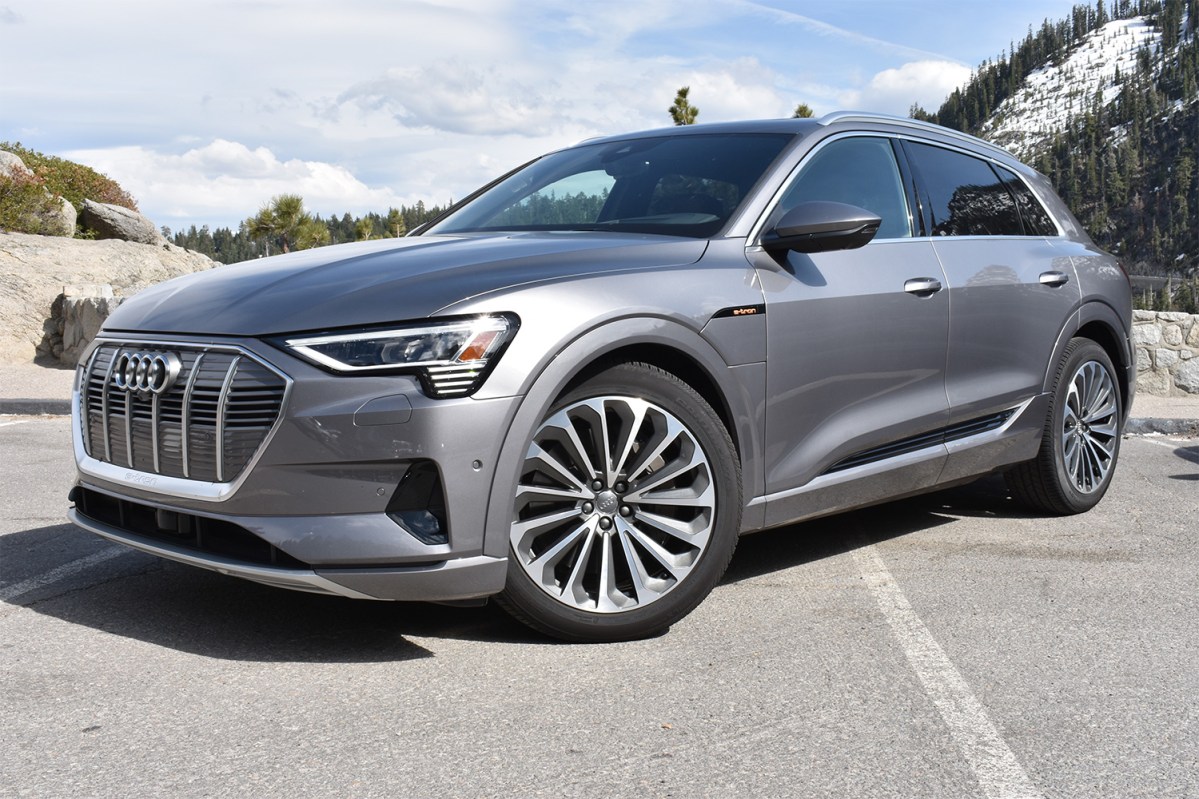
The E-Tron also falls short of the competition on maximum range. Its EPA-rated range of 204 miles is well behind the 234-mile Jaguar I-Pace and the 250-mile Tesla Model X Standard Range (Tesla also offers a pricier Long Range version with 325 miles of range). The E-Tron is rated to tow up to the 4,000 pounds, while the I-Pace isn’t rated for towing at all. But the Model X can tow up to 5,000 pounds.
On the road, the E-Tron is more pleasing to drive than the numbers suggest. It’s not overtly sporty (that will be the job of the upcoming , according to Audi. We certainly appreciated it while cornering, as the E-Tron felt more sure-footed than an SUV has any right to. It’s too bad that vague steering made it hard to make the most of that balance.
When it’s time to slow down, the E-Tron deploys an innovative braking system that blends conventional hydraulic brakes with range-replenishing regenerative braking. The driver just has to push the pedal, and the car decides which form of braking is best. Audi claims the system uses regenerative braking most of the time, and provided a live readout on an iPad to prove it. Indeed, we found that the car rarely engaged its hydraulic brakes even under pretty heavy braking. That helps recover energy, while also saving money on brake pads.
Rivals
Automakers are constantly talking about launching more electric cars, but for now the Audi E-Tron only has only a handful of rivals.
Jaguar I-Pace (base price: $70,495): Jaguar took the opposite approach to Audi in designing its first series-production electric car. The I-Pace is a futuristic showpiece that stands out, rather than attempting to blend in like the E-Tron. The Jag is quicker to 60 mph and offers more range than the Audi, but less cargo space. Jaguar’s infotainment system also lags behind Audi’s.
Tesla Model X (base price: $83,000): The E-Tron probably wouldn’t exist without Tesla, and the Model X maintains an advantage in range and performance. Tesla’s Autopilot system offers more capability than the E-Tron’s driver assists, and the Model X can be had with a third-row seat. But the E-Tron has a nicer interior, and 150-kilowatt charging capability, and feels more like a regular car.
The 2020 Mercedes-Benz EQC will likely be cross-shopped with the E-Tron as well, but U.S. specs and pricing haven’t been finalized, and the EQC won’t be available here until calendar year 2020.
Peace of mind
Audi offers a four-year, 50,000-mile, basic warranty and eight-year, 100,000-mile, battery warranty. The latter is comparable to battery coverage offered by Jaguar and Tesla on their electric cars. Because the E-Tron is a new vehicle, it is difficult to predict future reliability. Crash-test ratings are not available at this time.
How DT would configure this car
The 2019 Audi E-Tron is only available in two trim levels: Premium Plus and Prestige. The base Premium Plus model is fairly well equipped, with standard features like 20-inch wheels, full LED lighting, the MMI infotainment system, and a 16-speaker, 750-watt Bang & Olufsen audio system. But we would splurge for the Prestige to get features like a head-up display, Valcona leather, and adaptive cruise control.
Conclusion
The 2019 E-Tron was designed to be an Audi first, and an electric car second. That may disappoint people looking to make a statement about being tech savvy and eco friendly, but it might be the best approach to convince ordinary car buyers who are on the fence about electric cars. The E-Tron feels like a car of today, which could very well make it the car of tomorrow.

